Saltzman B. (editor) Anomalous Atmospheric Flows and Blocking
Подождите немного. Документ загружается.

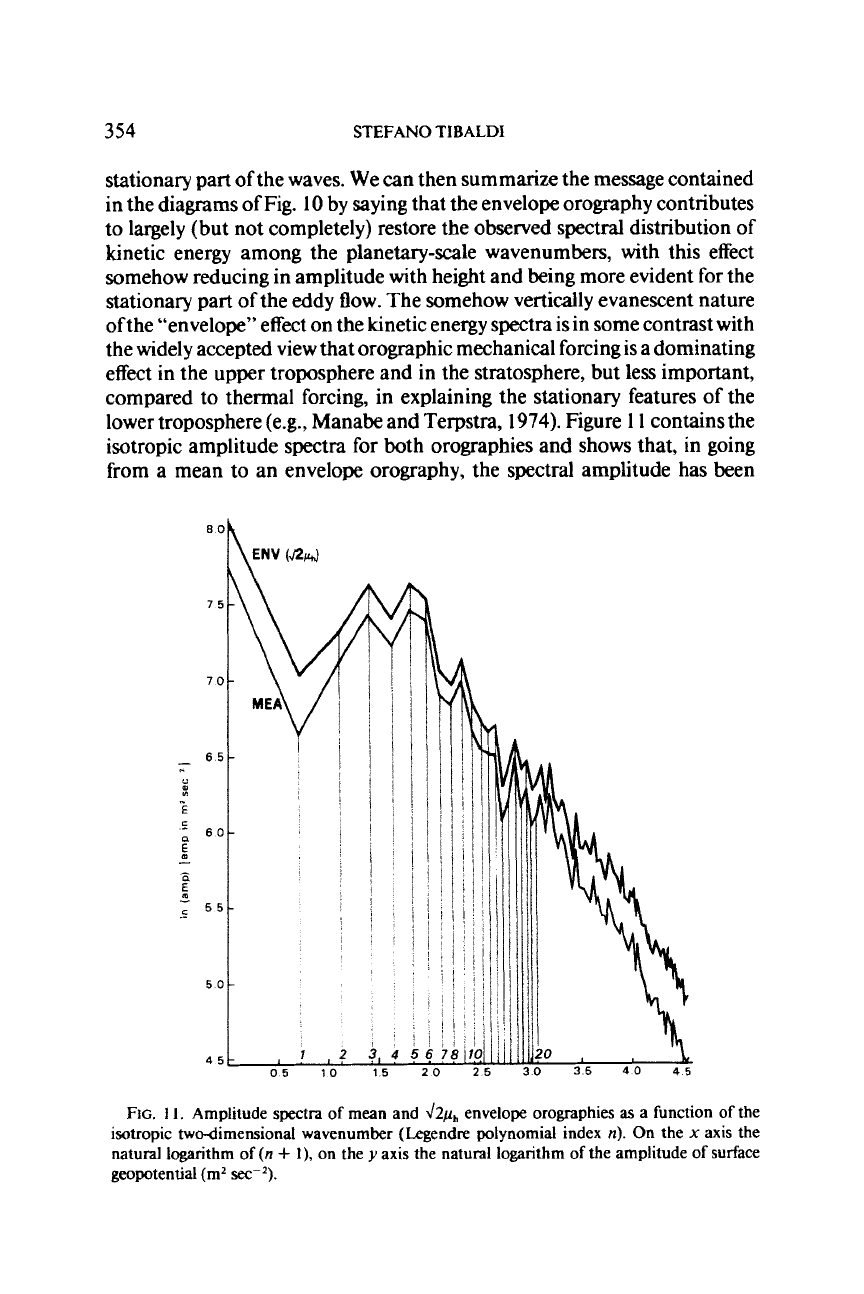
354
STEFAN0
TIBALDI
stationary part of the waves.
We
can then summarize the message contained
in the diagrams of Fig.
10
by saying that the envelope orography contributes
to largely (but not completely) restore the observed spectral distribution of
kinetic energy among the planetary-scale wavenumbers, with this effect
somehow reducing in amplitude with height and being more evident for the
stationary part of the eddy flow. The somehow vertically evanescent nature
of the “envelope” effect on the kinetic energy spectra is in some contrast with
the widely accepted view that orographic mechanical forcing
is
adominating
effect in the upper troposphere and in the stratosphere, but less important,
compared
to
thermal forcing, in explaining the stationary features of the
lower troposphere (e.g., Manabe and Terpstra, 1974). Figure
1 1
contains the
isotropic amplitude spectra for both orographies and shows that, in going
from a mean to an envelope orography, the spectral amplitude has been
BC
75
7c
65
-
4
E
‘
6C
z
-
-
5
5
55
-
5c
45
FIG.
1
1.
Amplitude spectra of mean and
J2fib
envelope orographies
as
a function
of
the
isotropic two-dimensional wavenumber (Legendre polynomial index
n).
On
the
x
axis the
natural logarithm of
(n
+
I),
on the
y
axis the natural logarithm of the amplitude
of
surface
geopotential (m2
se~-~).
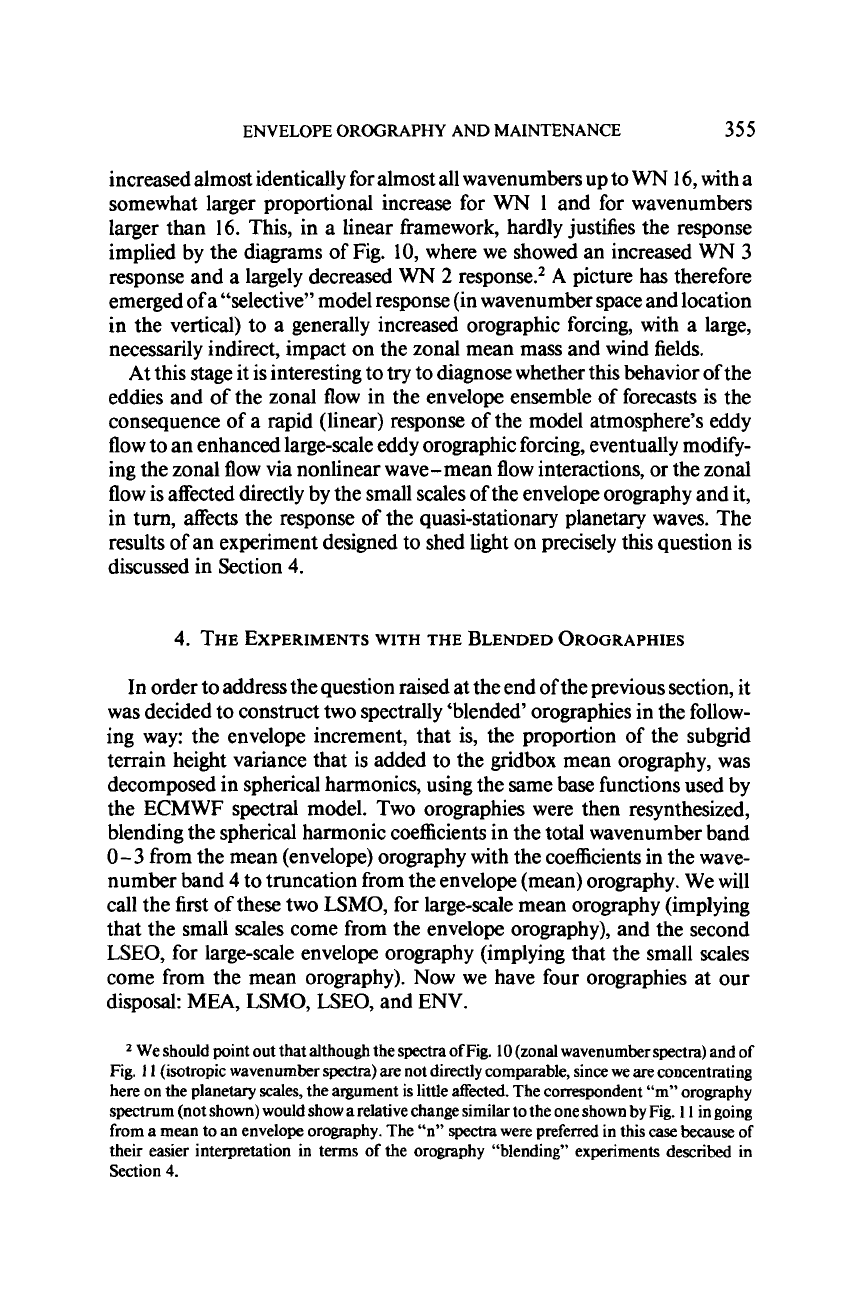
ENVELOPE OROGRAPHY AND MAINTENANCE
355
increased almost identically for almost all wavenumbers up to WN
16,
with a
somewhat larger proportional increase for
WN
1
and for wavenumbers
larger than
16.
This, in
a
linear framework, hardly justifies the response
implied by the diagrams of Fig.
10,
where we showed an increased
WN
3
response and a largely decreased
WN
2
response.2
A
picture has therefore
emerged of a “selective” model response (in wavenumber space and location
in the vertical) to a generally increased orographic forcing, with a large,
necessarily indirect, impact on the zonal mean mass and wind fields.
At this stage it
is
interesting to try to diagnose whether this behavior of the
eddies and of the zonal flow in the envelope ensemble
of
forecasts is the
consequence of a rapid (linear) response of the model atmosphere’s eddy
flow to an enhanced large-scale eddy orographic forcing, eventually modify-
ing the zonal flow via nonlinear wave-mean flow interactions, or the zonal
flow is affected directly by the small scales of the envelope orography and it,
in turn, affects the response of the quasi-stationary planetary waves. The
results of an experiment designed to shed light on precisely this question is
discussed in Section
4.
4.
THE
EXPERIMENTS
WITH THE
BLENDED
OROGRAPHIES
In order to address the question raised at the end of the previous section, it
was decided to construct two spectrally ‘blended’ orographies in the follow-
ing way: the envelope increment, that is, the proportion of the subgrid
terrain height variance that is added to the gridbox mean orography, was
decomposed in spherical harmonics, using the same base functions used by
the ECMWF spectral model. Two orographies were then resynthesized,
blending the spherical harmonic coefficients in the total wavenumber band
0-
3
from the mean (envelope) orography with the coefficients in the wave-
number band
4
to truncation from the envelope (mean) orography. We will
call the first
of
these two LSMO, for large-scale mean orography (implying
that the small scales come from the envelope orography), and the second
LSEO,
for large-scale envelope orography (implying that the small scales
come from the mean orography). Now we have four orographies at our
disposal: MEA, LSMO,
LSEO,
and ENV.
*
We should point out that although the spectra of Fig.
10
(zonal wavenumber spectra) and
of
Fig.
1
I
(isotropic wavenumber spectra) are not directly comparable, since we
are
concentrating
here on the planetary scales, the argument is little affected. The correspondent “m” orography
spectrum (not shown) would show a relative change similar to the one shown by Fig.
1 1
in going
from a mean to an envelope orography. The “n”
spectra
were preferred in this case
because
of
their easier interpretation in terms of the orography “blending” experiments described in
Section
4.
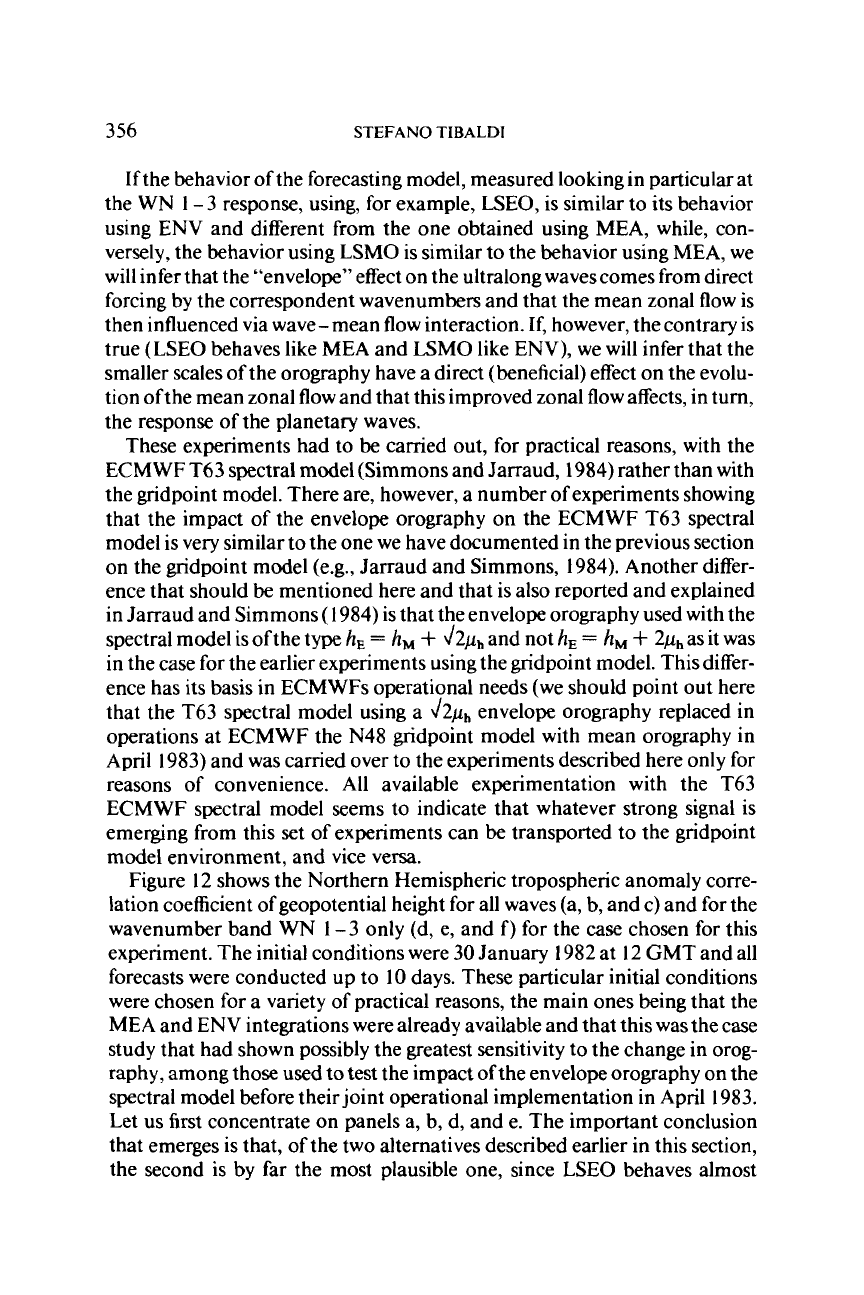
356
STEFAN0
TIBALDI
If
the behavior of the forecasting model, measured looking in particular at
the
WN
I
-
3
response, using, for example,
LSEO,
is
similar
to
its behavior
using
ENV
and different from the one obtained using
MEA,
while, con-
versely, the behavior using
LSMO
is
similar to the behavior using
MEA,
we
will infer that the “envelope” effect on the ultralong wavescomes from direct
forcing by the correspondent wavenumbers and that the mean zonal flow is
then influenced via wave- mean flow interaction.
If,
however, the contrary is
true
(LSEO
behaves like
MEA
and
LSMO
like ENV), we will infer that the
smaller scales of the orography have a direct (beneficial) effect on the evolu-
tion ofthe mean zonal flow and that this improved zonal flow affects, in turn,
the response of the planetary waves.
These experiments had to
be
canied out, for practical reasons, with the
ECMWF
T63
spectral model (Simmons and Jarraud, 1984) rather than with
the gridpoint model. There are, however, a number
of
experiments showing
that the impact
of
the envelope orography on the
ECMWF
T63 spectral
model is very similar to the one we have documented in the previous section
on the gridpoint model (e.g., Jarraud and Simmons, 1984). Another differ-
ence that should be mentioned here and that is also reported and explained
in Jarraud and Simmons
(
1984) is that the envelope orography used with the
spectral model is of the type
h,
=
h,
+
J2ph
and not
h,
=
hM
+
2j4,
as it was
in the case for the earlier experiments using the gridpoint model. This differ-
ence has its basis in
ECMWFs
operational needs (we should point out here
that the T63 spectral model using a
421h
envelope orography replaced in
operations at
ECMWF
the N48 gridpoint model with mean orography in
April 1983) and was canied over to the experiments described here only for
reasons of convenience.
All
available experimentation with the T63
ECMWF
spectral model seems to indicate that whatever strong signal is
emerging from this set
of
experiments can
be
transported to the gridpoint
model environment, and vice versa.
Figure
12
shows the Northern Hemispheric tropospheric anomaly corre-
lation coefficient of geopotential height for all waves (a, b, and c) and for the
wavenumber band
WN
1-3 only (d, e, and f) for the
case
chosen for this
experiment. The initial conditions were 30 January 1982 at
12
GMT
and all
forecasts were conducted up to
10
days. These particular initial conditions
were chosen
for
a variety of practical reasons, the main ones being that the
MEA
and
ENV
integrations were already available and that this was the case
study that had shown possibly the greatest sensitivity to the change in
orog-
raphy, among those
used
to
test the impact
of
the envelope orography on the
spectral model before their joint operational implementation in April 1983.
Let
us
first concentrate on panels a, b, d, and e. The important conclusion
that emerges is that, of the two alternatives described earlier in this section,
the second
is
by
far the most plausible one, since
LSEO
behaves almost
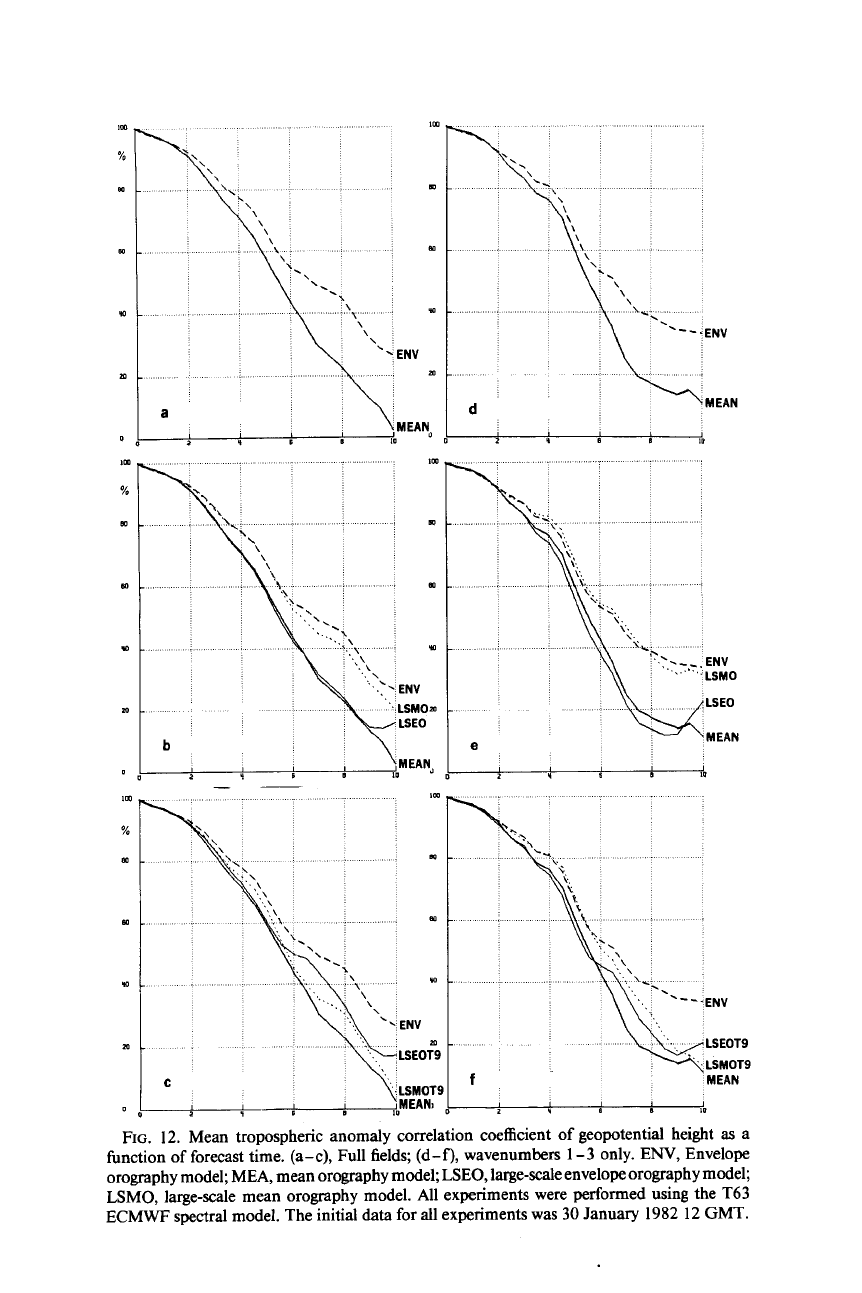
ENV
MEAN
FIG.
12. Mean tropospheric anomaly correlation coefficient of geopotential height
as
a
function of forecast time. (a-c), Full fields; (d-f), wavenumbers
1-3
only.
ENV,
Envelope
orography model; MEA, mean orography model;
LSEO,
large-scale envelope orography model;
LSMO, large-scale mean orography model. All experiments were performed using the T63
ECMWF spectral model. The initial
data
for
all
experiments was 30 January 1982
12
GMT.
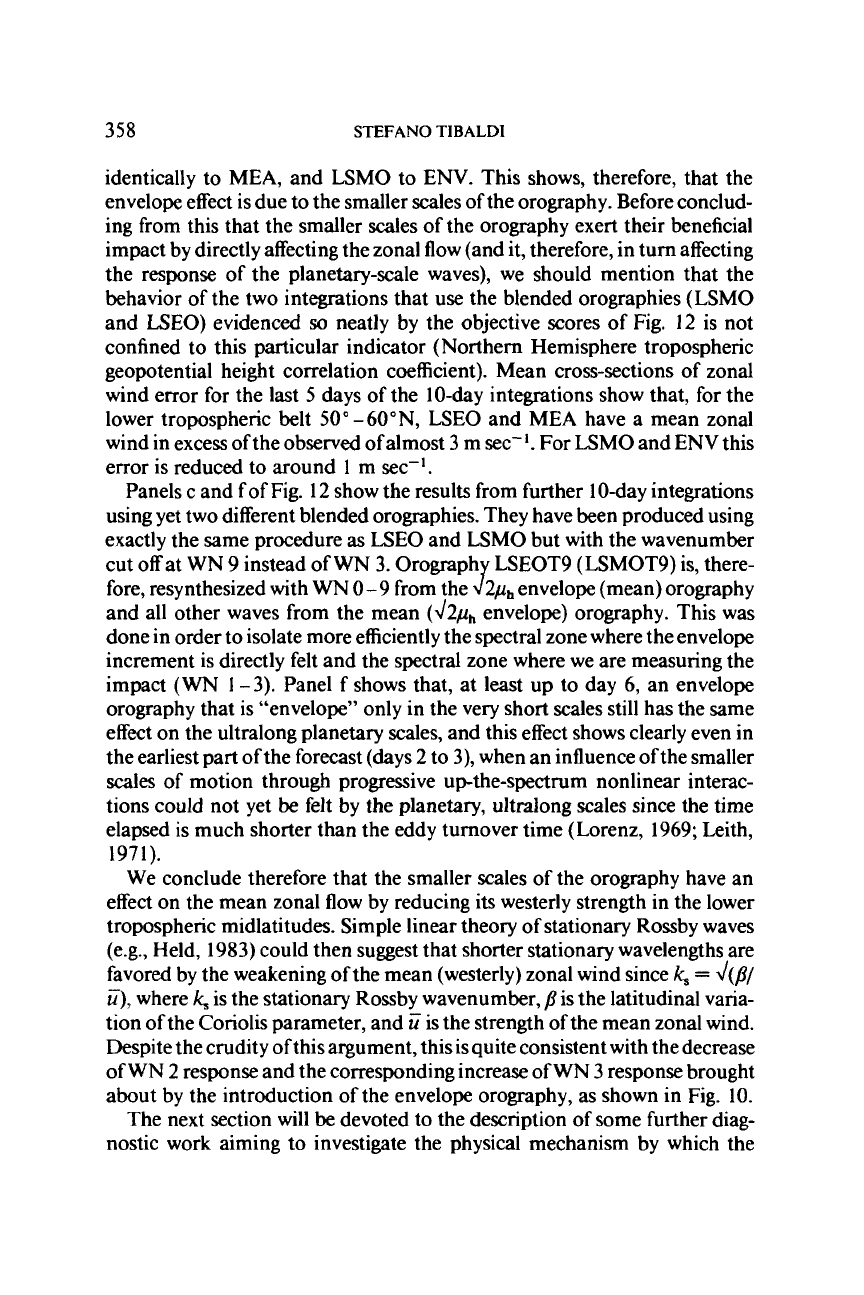
358
STEFAN0
TlBALDl
identically to MEA, and LSMO to ENV. This shows, therefore, that the
envelope effect is due to the smaller scales of the orography. Before conclud-
ing from this that the smaller scales of the orography exert their beneficial
impact by directly affecting the zonal flow (and it, therefore, in turn affecting
the response of the planetary-scale waves), we should mention that the
behavior of the two integrations that use the blended orographies (LSMO
and
LSEO)
evidenced
so
neatly by the objective scores of Fig.
12
is not
confined to this particular indicator (Northern Hemisphere tropospheric
geopotential height correlation coefficient). Mean cross-sections of zonal
wind error for the last
5
days of the
10-day
integrations show that, for the
lower tropospheric belt
50”
-60”N,
LSEO
and MEA have a mean zonal
wind in excess ofthe observed ofalmost
3
m sec-I. For
LSMO
and ENV this
error is reduced to around
1
m sec-’.
Panels c and
f
of Fig.
I2
show the results from further 10-day integrations
using yet two different blended orographies. They have been produced using
exactly the same procedure
as
LSEO
and LSMO but with the wavenumber
cut off at WN
9
instead of
WN
3.
Orograph
LSEOT9
(LSMOT9) is, there-
and all other waves from the mean
(J2ph
envelope) orography. This was
done in order to isolate more efficiently the spectral zone where the envelope
increment is directly felt and the spectral zone where we are measuring the
impact
(WN
I
-3).
Panel
f
shows that, at least up to day
6,
an envelope
orography that is “envelope” only in the very short scales still has the same
effect on the ultralong planetary scales, and this effect shows clearly even in
the earliest part of the forecast
(days
2
to
3),
when an influence of the smaller
scales of motion through progressive up-the-spectrum nonlinear interac-
tions could not yet
be
felt by the planetary, ultralong scales since the time
elapsed is much shorter than the eddy turnover time (Lorenz,
1969;
kith,
1971).
We conclude therefore that the smaller scales
of
the orography have an
effect
on
the mean zonal flow by reducing its westerly strength in the lower
tropospheric midlatitudes. Simple linear theory of stationary Rossby waves
(e.g., Held,
1983)
could then suggest that shorter stationary wavelengths are
favored by the weakening
of
the mean (westerly) zonal wind since
k,
=
d(p/
U),
where
k,
is the stationary Rossby wavenumber, pis the latitudinal varia-
tion of the Coriolis parameter, and
U
is the strength of the mean zonal wind.
Despite the crudity of this argument, this is quite consistent with the decrease
of WN
2
response and the corresponding increase of
WN
3
response brought
about by the introduction of the envelope orography,
as
shown in Fig.
10.
The next section will be devoted to the description of some further diag-
nostic work aiming to investigate the physical mechanism by which the
fore, resynthesized with
WN
0-9
from the
Y
2,uh
envelope (mean) orography
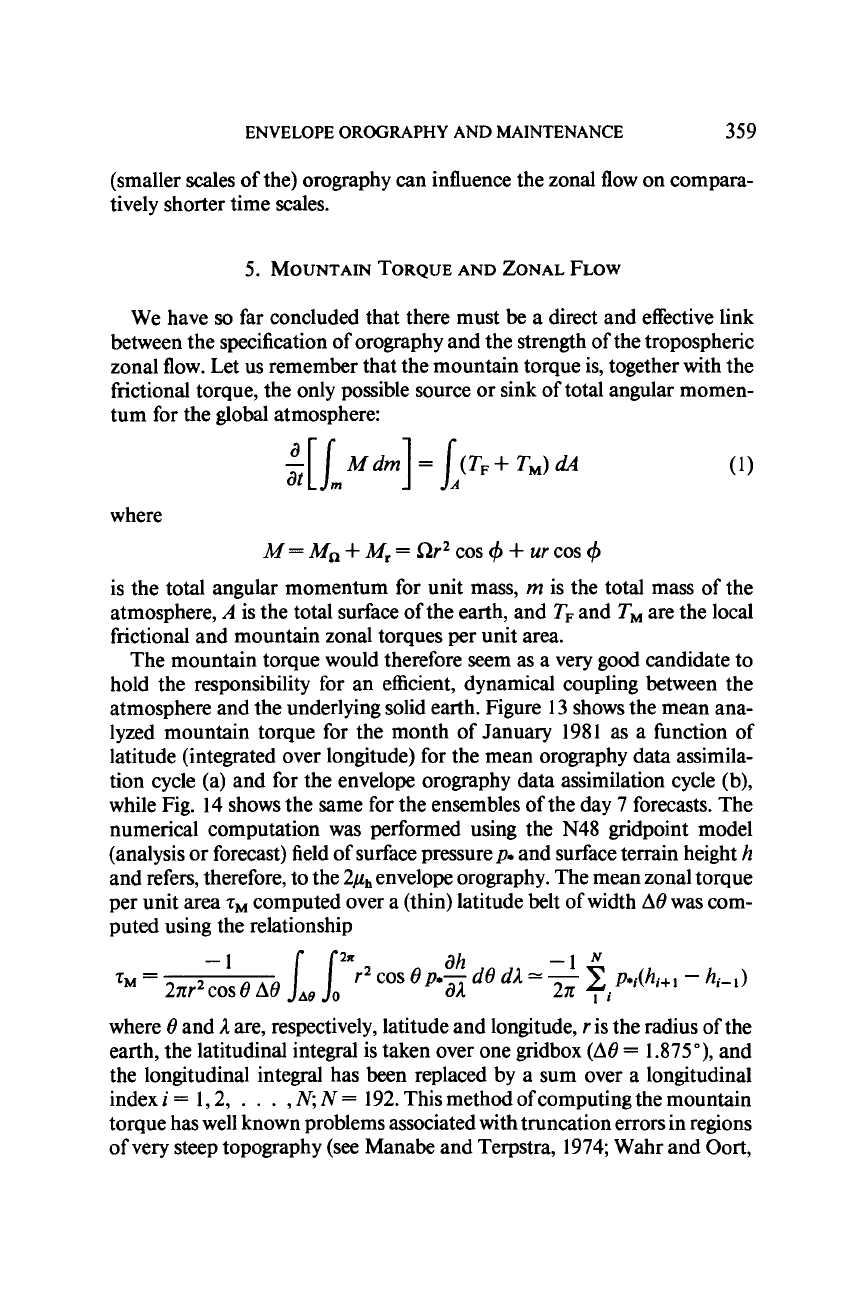
ENVELOPE
OROGRAPHY
AND MAINTENANCE
359
(smaller scales of the) orography can influence the zonal flow on compara-
tively shorter time scales.
5.
MOUNTAIN TORQUE
AND
ZONAL FLOW
We have
so
far concluded that there must be a direct and effective link
between the specification of orography and the strength of the tropospheric
zonal flow. Let us remember that the mountain torque is, together with the
frictional torque, the only possible source or sink of total angular momen-
tum for the global atmosphere:
where
M=
Mn
+
M,
=
RrZ
cos
4
+
ur
cos
4
is the total angular momentum for unit mass,
rn
is the total mass of the
atmosphere,
A
is the total surface of the earth, and
TF
and
TM
are the local
frictional and mountain zonal torques per unit area.
The mountain torque would therefore seem as a very good candidate to
hold the responsibility for an efficient, dynamical coupling between the
atmosphere and the underlying solid earth. Figure
13
shows the mean ana-
lyzed mountain torque for the month of January
1981
as
a function of
latitude (integrated over longitude) for the mean orography data assimila-
tion cycle (a) and for the envelope orography data assimilation cycle (b),
while Fig.
14
shows the same for the ensembles of the day
7
forecasts. The
numerical computation was performed using the
N48
gridpoint model
(analysis or forecast) field of surface pressure
p.
and surface terrain height
h
and refers, therefore, to the
2ph
envelope orography. The mean zonal torque
per unit area
7M
computed over a (thin) latitude belt of width
A8
was com-
puted using the relationship
ah
-1
a1
2~
li
rz
cos
8p.-
d8
d1
=
-
C
p.i(hi+l
-
2nr2
-I
cos
8
A8
I
Ae
I"
7,
=
where
8
and
1
are, respectively, latitude and longitude,
r
is the radius of the
earth, the latitudinal integral is taken over one gridbox
(A8
=
1.875"),
and
the longitudinal integral has been replaced by a sum over a longitudinal
index
i
=
1,2,
.
.
.
,
N;
N
=
192.
This method of computing the mountain
torque has well known problems associated with truncation errors in regions
of very steep topography (see Manabe and Terpstra,
1974;
Wahr and Oort,
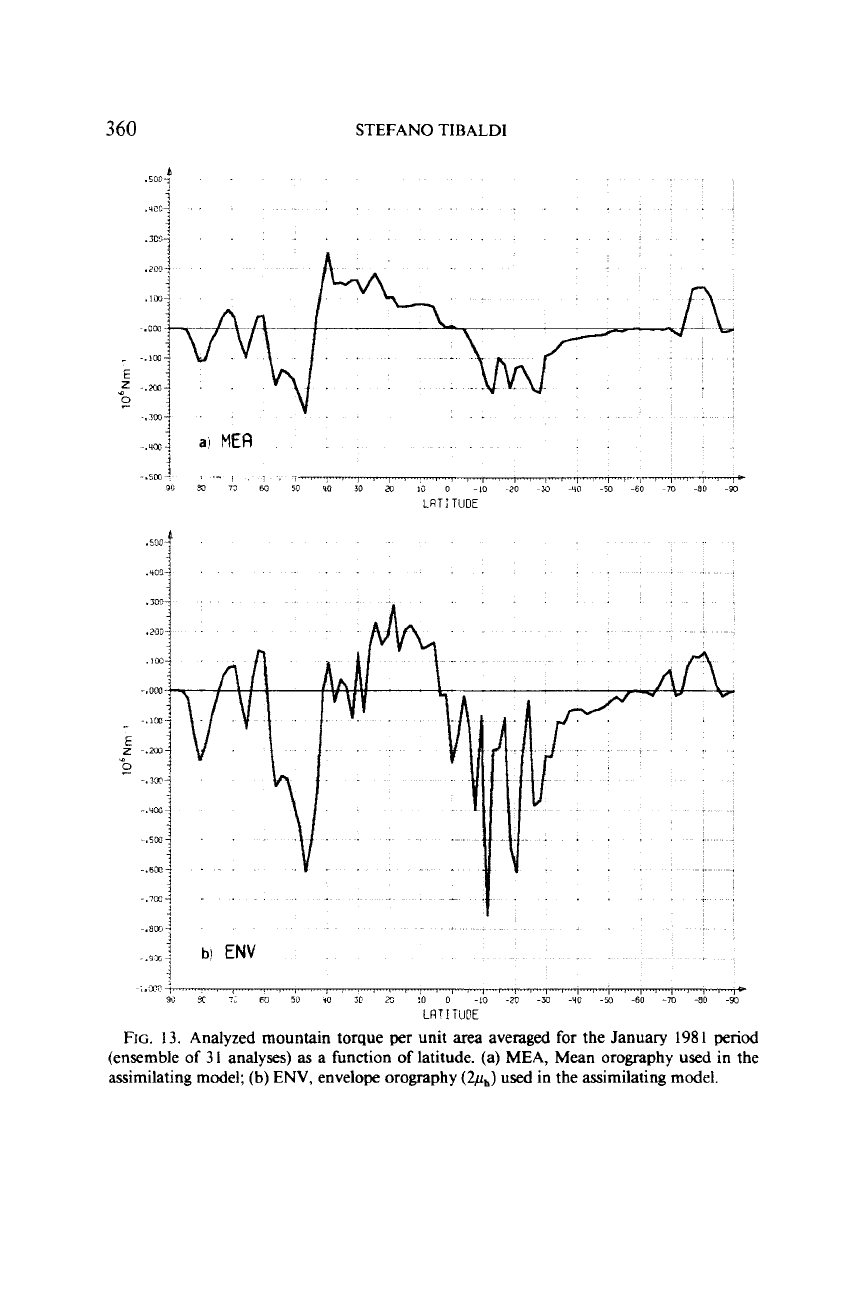
360
.50c
.“OC
.
JP’
.20c
.ill
-.om
-.I@
E
,z
-.m
5!
-.3m
~.UOc
-.Sffi
STEFAN0
TIBALDI
ai
MER
I
-,
-,
I I
>,
I,,
,
I
,--.-
S2 73
M
50
YQ
30
13
0
-10
20
50
40
-yI
-60
70
-8Q
-53
LRT
1
TUDE
bi
ENV
.3?
%,
d
m
JL‘
x:
:c
r;
:o
o
-10
-20
-XI
-yo
n
60
m
80
-90
LRT
I
iUCE
FIG.
13.
Analyzed mountain torque
per
unit
area
averaged for the January
198
I
period
(ensemble of
3
I
analyses)
as
a function
of
latitude. (a) MEA, Mean orography
used
in the
assimilating model; (b)
ENV,
envelope orography
(2,~~)
used
in the assimilating model.
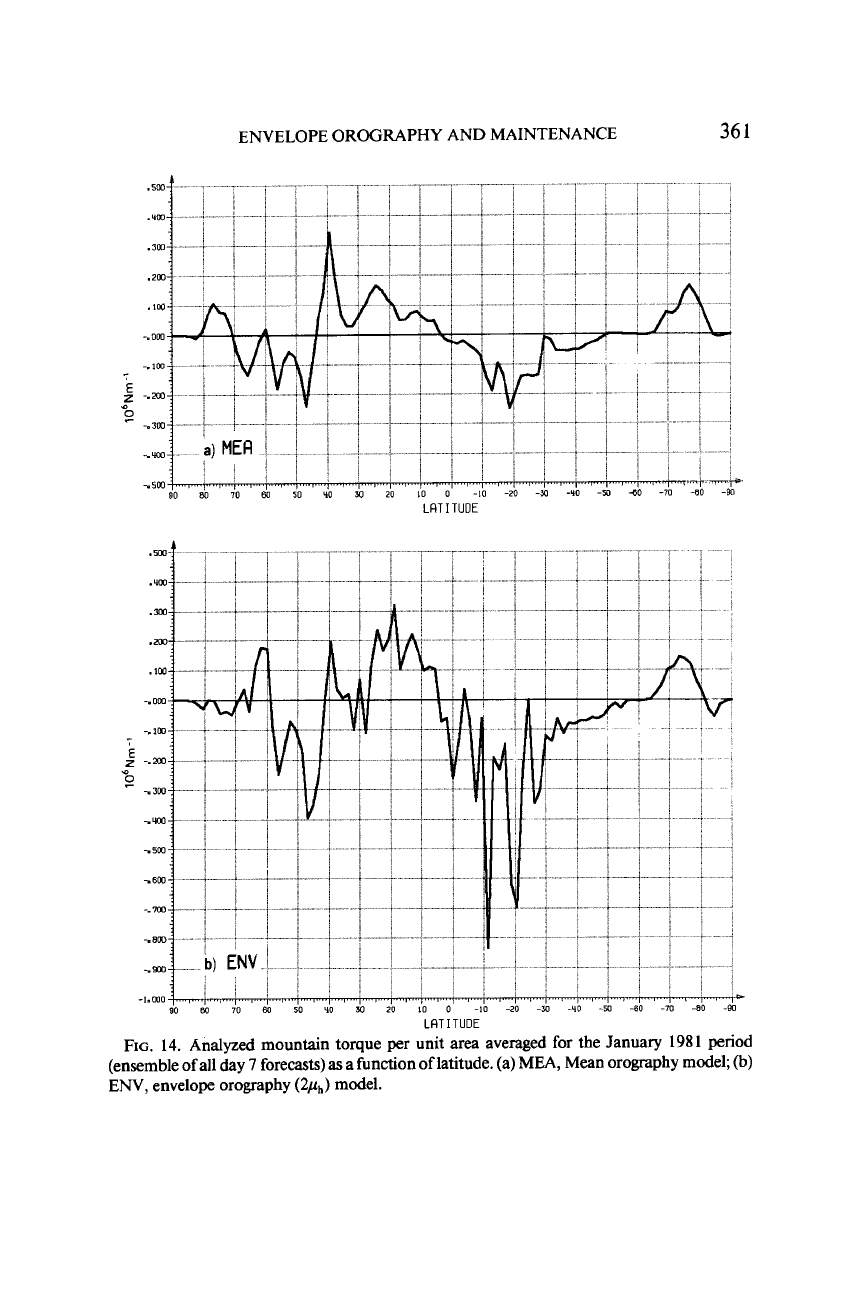
ENVELOPE OROGRAPHY AND MAINTENANCE
36
1
..
-
L-
1-
-+,
.
*-
,-,
*
i
.
.-i-
r
LRTITUDE
FIG.
14. Analyzed mountain torque per unit area averaged for the January 1981 period
(ensemble of all day
7
forecasts)
as
a function of latitude. (a) MEA, Mean orography model;
(b)
ENV, envelope orography
(2&)
model.
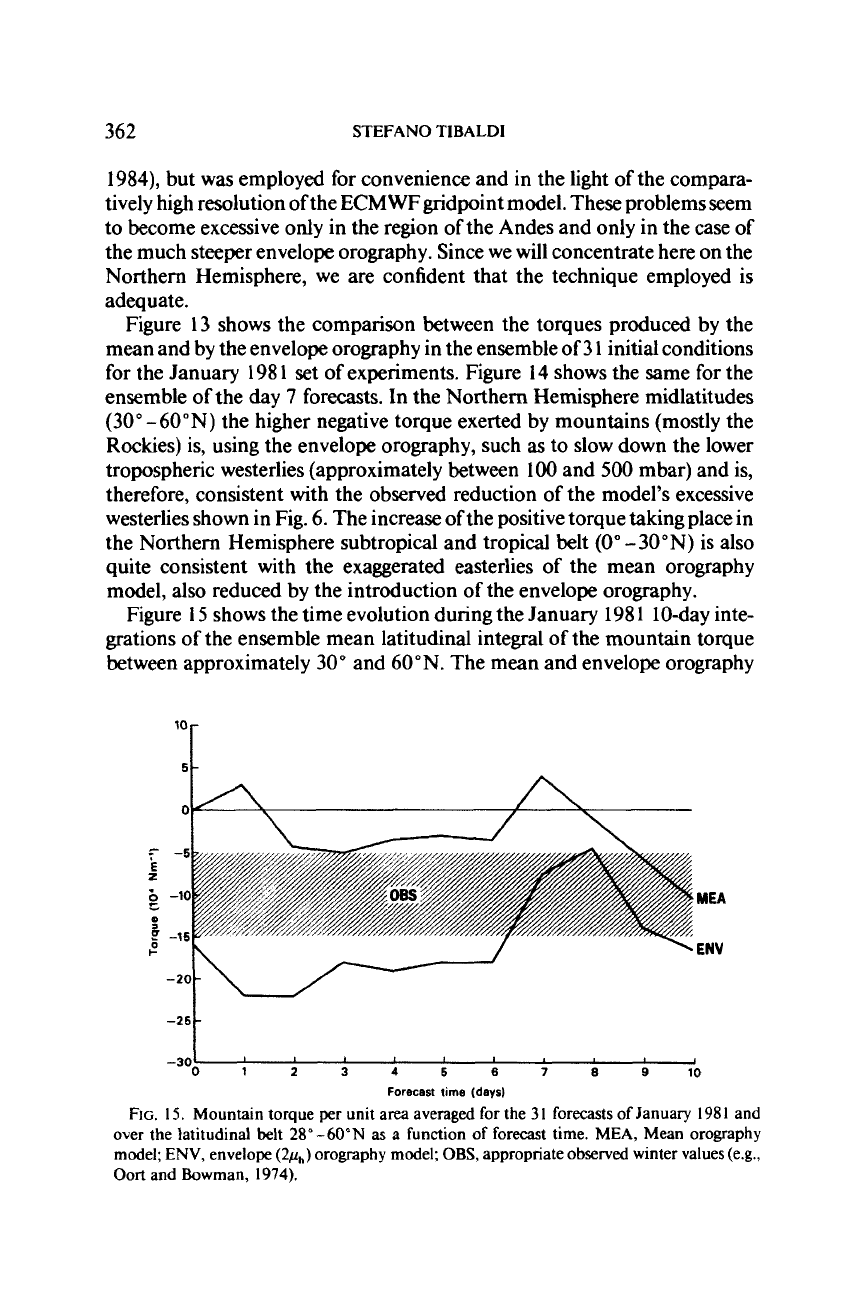
362
STEFAN0 TlBALDl
1984), but was employed for convenience and in the light of the compara-
tively high resolution ofthe ECMWFgridpoint model. These problems seem
to become excessive only in the region
of
the Andes and only in the case of
the much steeper envelope orography. Since we will concentrate here on the
Northern Hemisphere, we are confident that the technique employed is
adequate.
Figure 13 shows the comparison between the torques produced by the
mean and by the envelope orography in the ensemble of 3
1
initial conditions
for the January 198
1
set of experiments. Figure
14
shows the same for the
ensemble of the
day
7
forecasts. In the Northern Hemisphere midlatitudes
(30" -60"N) the higher negative torque exerted by mountains (mostly the
Rockies) is, using the envelope orography, such
as
to slow down the lower
tropospheric westerlies (approximately between
100
and
500
mbar) and is,
therefore, consistent with the observed reduction
of
the model's excessive
westerlies shown in Fig.
6.
The increase of the positive torque taking place in
the Northern Hemisphere subtropical and tropical belt
(Oo
-30"N) is also
quite consistent with the exaggerated easterlies of the mean orography
model, also reduced by the introduction of the envelope orography.
Figure 15 shows the time evolution during the January 198
1
10-day inte-
grations of the ensemble mean latitudinal integral of the mountain torque
between approximately 30" and 60"N. The mean and envelope orography
MEA
ENV
-301
1
I I
I
0
12
3
4
5
8
7
8
9
10
Forecast
time
(days)
FIG.
15.
Mountain torque
per
unit area averaged for the
31
forecasts
of
January
1981
and
over the latitudinal belt
28"-60"N
as
a function of forecast time. MEA, Mean orography
model;
ENV,
envelope
(24,)
orography model; OBS, appropriate observed winter values (e.g.,
Oort
and Bowman,
1974).
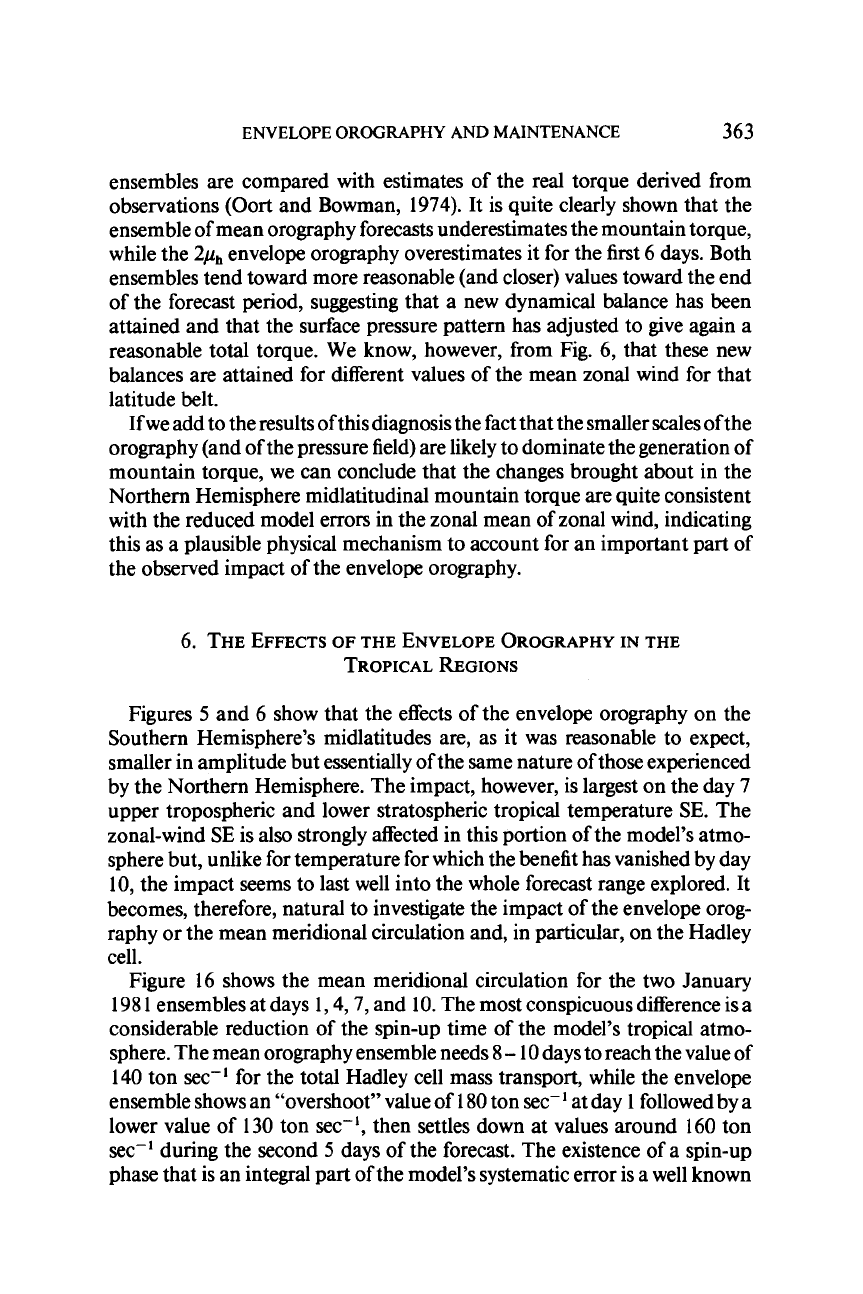
ENVELOPE OROGRAPHY AND MAINTENANCE
363
ensembles are compared with estimates of the real torque derived from
observations (0013 and Bowman, 1974). It is quite clearly shown that the
ensemble of mean orography forecasts underestimates the mountain torque,
while the
2ph
envelope orography overestimates it for the first 6 days. Both
ensembles tend toward more reasonable (and closer) values toward the end
of the forecast period, suggesting that a new dynamical balance has been
attained and that the surface pressure pattern has adjusted to give again a
reasonable total torque. We know, however, from Fig. 6, that these new
balances are attained for different values of the mean zonal wind for that
latitude belt.
If we add to the results of this diagnosis the fact that the smaller scales of the
orography (and of the pressure field) are likely to dominate the generation of
mountain torque, we can conclude that the changes brought about in the
Northern Hemisphere midlatitudinal mountain torque are quite consistent
with the reduced model errors in the zonal mean of zonal wind, indicating
this as
a
plausible physical mechanism to account for an important part of
the observed impact of the envelope orography.
6. THE EFFECTS
OF
THE
ENVELOPE OROGRAPHY
IN
THE
TROPICAL
REGIONS
Figures
5
and 6 show that the effects of the envelope orography on the
Southern Hemisphere’s midlatitudes are, as it was reasonable to expect,
smaller in amplitude but essentially of the same nature of those experienced
by the Northern Hemisphere. The impact, however, is largest on the day 7
upper tropospheric and lower stratospheric tropical temperature
SE.
The
zonal-wind SE is also strongly affected in this portion of the model’s atmo-
sphere but, unlike for temperature for which the benefit has vanished by day
10,
the impact seems to last well into the whole forecast range explored. It
becomes, therefore, natural to investigate the impact of the envelope orog-
raphy or the mean meridional circulation and, in particular, on the Hadley
cell.
Figure 16 shows the mean meridional circulation for the two January
198
1
ensembles at days 1,4,7, and 10. The most conspicuous difference is a
considerable reduction of the spin-up time of the model’s tropical atmo-
sphere. The mean orography ensemble needs
8
-
10 days to reach the value of
140 ton sec-’ for the total Hadley cell mass transport, while the envelope
ensemble shows an “overshoot” value of 180 ton sec-’ at day
1
followed by a
lower value of 130 ton sec-’, then settles down at values around 160 ton
sec-’ during the second
5
days of the forecast. The existence of a spin-up
phase that is an integral part of the model’s systematic error is a well known
